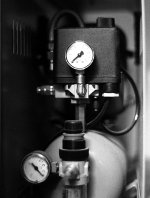Types of Air Conditioning Compressors
Author: John Published Under: Home

Today, we no longer have to rely on fans or bricks of ice to keep cool in the summer, with most Western Countries using Air Conditioning Units to control temperature. One of the most important components of an Air Conditioner is the compressor.
Centrifugal Compressors
A Centrifugal Compressor have multiple impellers, which fling the refrigerant away from the compressor as it spins. Often, centrifugal compressors are used on very large HVAC systems, often on open systems or semi-hermetic systems.
There is no pistons, rods, or valves on a centrifugal compressor, so the only area that wears down is the shaft bearings. These types of compressors are powered by either an electric motor or some sort of steam turbine, with vapors entering the intake, which is located near the impeller shaft. As the impeller shaft turns, its energy transfers to the gas, resulting in a very high velocity system.
It is possible to regulate a centrifugal compressor by limiting the amount of gas let into the system, as well as the direction at which the gas enters the system.
Having proper refrigerant levels is very important, because flood back on the compressor can cause serious damage.
Helical Compressors
Helical Compressors, which are often called screw compressors, are used in large HVAC systems, typically with a minimum capacity of 20 tons. A pair of helical screws is rotated, although sometimes rotors are used, which forces the refrigerant to the bottom of the compressor. These types of compressors are usually used in open systems, but can also be used in hermetic systems.
Rotary Compressors
Rotary Compressors use one, or sometimes more, blades to create compression, but do not have a piston as would be found in a reciprocating compressor. There are two types, rotating blade or stationary blade.
In a rotating blade compressor, an off center shaft rotates I the cylinder, turning the blades. This type of compressor is very efficient.
Stationary Blade compressors, a sliding blade is used to separate low pressure vapor from high pressure vapor. As the impeller rotates, powered by the compressor shaft, vapor is drawn from the suction line and pushed towards the discharge port.
Scroll Compressor
The Scroll Compressor looks a little bit like the burner on an electric stove, with spiral scrolls being mounted inside of one another. Vapor is drawn into the end of the scroll and as the scroll spins, it is forced towards the center of the scroll.
From a maintenance standpoint, the scroll compressor offers several advantages. It is often 100% oil free, does not produce a lot of vibration or noise, has few parts that can wear down, and it is generally very efficient. However, they can only operate in one direction, so if the current is switched by accident, it can seriously damage the HVAC unit.
Reciprocating Compressors
The Reciprocating Compressor uses a piston to compress the refrigerant, operating very similar to a small gasoline engine like you would find on a riding lawnmower. It has an intake stroke, which draws refrigerant into the cylinder, and a compression stroke, which forces the piston up, compressing the refrigerant.
In a small system, the motor will usually only have one piston, but larger systems can have more than one piston. One difference between reciprocating compressors and small gas engines is that the reciprocating compressor is usually made out of cast iron, as opposed to aluminum.
However, like a gasoline engine, there are a number of seals and gaskets, like oil rings and compression rings, which are required to create compression.